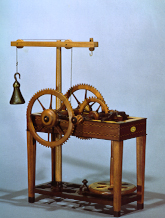
87.9 x 22.5 x 30
Carved wood
CAT. 1824 : D.I.29
Um guindaste com um sarilho, em cujas extremidades se achão rodas dentadas, que engranzão em outras de um eixo, onde se envolve a corda, que serve para levantar o pezo. Tem uma peça, que se introduz em alguns dentes, que se achão o eiso do sarilho, para se parar quando se quizer, e ficar o pezo suspenso. N.B. Está muito mal construido nunca teve uso.
A crane with a reel, at the end of which are cogwheels which engage with other cogwheels mounted on another axle; the rope used for lifting the weight is wound round this axle. It has a part which can be placed between the teeth at the axle of the reel, to stop the movement and keep the weight suspended. N.B. It is very badly made and has never been used.
This crane consists of two wooden cylinders with a cogwheel at each end. The cylinder which acts as a reel has two small cogwheels; near the middle of the other cylinder, with two larger cogwheels, are four arms forming a cross, perpendicular to the axle. These arms act as a lever which allows the user to turn the set of cogwheels, and these, engaging in pairs, transmit the rotation to the reel. A rope, connected to the end of one of the arms of the crane by a pulley, winds round the reel and lifts a body suspended from the other end.
The supports for the cylinders and cogwheels stand on an H-shaped platform mounted on the main column of the crane. A wooden structure, extending from the base of the machine to a level on the column just below the bottom of the platform, ensures stability.
To move the suspended object in the horizontal plane, the horizontal wooden beam of the crane can be manoeuvred by a rope hooked to the opposite end from the pulley, causing the beam to rotate around its vertical support column.